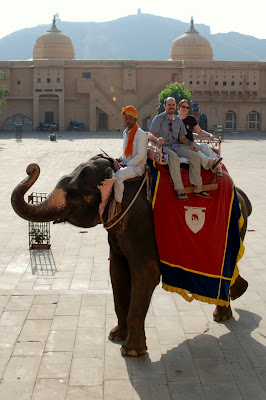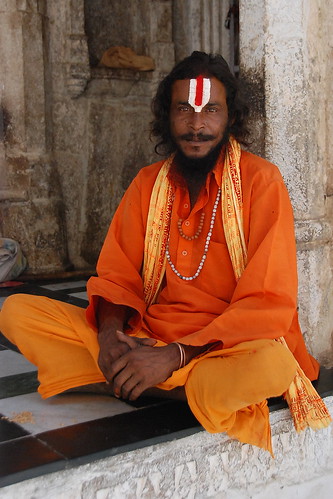
Remember the first time you peeked under the hood of a car? You found a perplexing mix of steaming pipes, colorful wires and gleaming chrome. It was confusing and fascinating all at the same time.
Such is India.
With over one billion people and hundreds of regional dialects, perplexing doesn't even begin to describe the country. Add to it a religion of the majority -- Hinduism -- that features literally millions of gods and a geography that spans Himalayan peaks to palm-lined beaches, you get a sense of the vastness that is the sub-continent.
We had less than two weeks for our Indian appetizer so we had to be very selective. We chose to focus our time in the northern part of the country, stretching from the northeastern region of Rajasthan to the holy town of Varanasi in the state of Uttar Pradesh. What we found was a country rich in history and steeped in tradition while, at the same time, dealing with globalization and an increasing divide between rich and poor.

We arrived in New Delhi in the middle of the night and were happy to find our ride into the city waiting for us outside the airport. Under the soft yellow glow of Delhi's street lights, two things became clear on our 30 minute drive into the city: it is a place in transition and there exists a large gap between the 'haves' and the 'have nots'. Construction cranes were in motion in the pre-dawn hours, while shiny new cars cruised under highway overpasses that gave shelter to Delhi's homeless.
After a few hours of sleep, we set off to explore the Old Town. The narrow lanes surrounding the Jama Masjid mosque were jammed with people, bicycles, cows and produce. A tangled web of spliced power lines seemed to tie the buildings together overhead. We watched people go about their daily routine from the back of a pedal rickshaw.
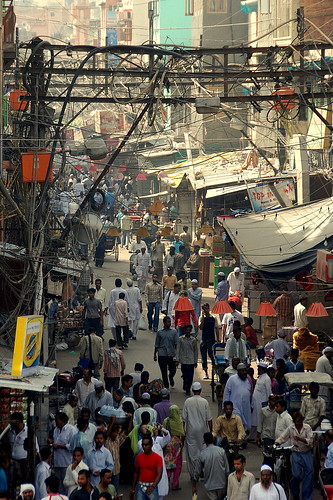
At Raj Ghat, we stood at the spot where Mahatma Gandhi was cremated after being assassinated in 1948. A small group of men sat at the foot of the simple black marble memorial and sang quiet songs in his memory
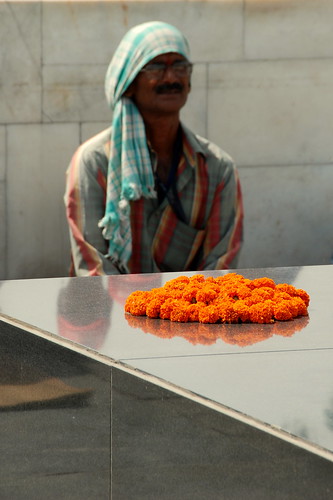
The next morning, we were on the train platform before dawn to catch our train to Agra. The rail station was full of people at such an early hour ... we tiptoed around sleeping bodies and bundled packages, waiting for their ride home. Rats scurried about on the tracks and darted back into sewer pipes at the first sound of our approaching train.
From our carriage, we watched the rising sun dance across the city's rooftops as they flashed past the window. The seemingly endless slums on the outskirts of Delhi finally gave way to open green fields dotted with palm trees. As the train attendant came by with hot milk for my corn flakes, I turned my attention to the newspaper. The matrimonial section was particularly interesting, with ads such as...
"Well qualified working soul mate required for very handsome Sikh Khatri boy. 30 yrs, 5'-9", MBA, working as Manager in MNC at Chandigarh. Contact with snap, date, place, time of birth."
Nothing can really prepare you for seeing something like the Taj Mahal in person. No matter how many photos you have seen before, to see the Taj with your own eyes is something else altogether.
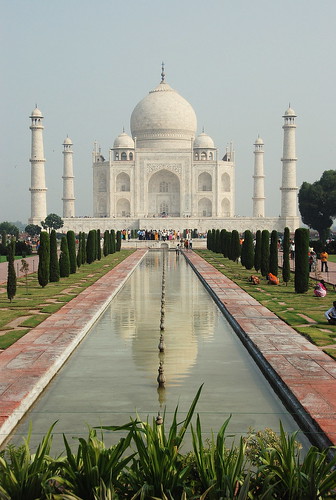
The building almost glowed in the morning sun, helped by its unique translucent marble inlayed with semi-precious stones ... something you don't notice until you see it up close.
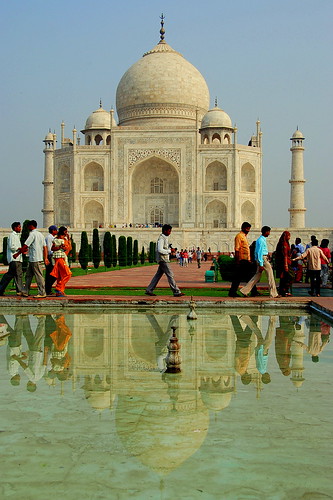
The Taj was built over a period of 22 years with the help of some 20,000 laborers and has been described as the ultimate testament to love. Our guide led us through the dark interior, pointing out the only non-symmetrical part of the monument -- the tomb of Emperor Shah Jahan lays to the side of his wife for whom he had the Taj constructed. In another room, he holds his pen flashlight against the wall to demonstrate its translucence. An inlayed flower made of carnelian glowed a brilliant red against the soft white marble wall.
We were pleasantly surprised that Agra was not a one-hit wonder. The nearby Agra Fort towers over banks of the Yamuna River was once a military structure but was eventually transformed into a palace. Further down the river, the Itimad-Ud-Daulah, or Baby Taj, was the first Mughal structure made entirely from marble and featured extensive inlay work.
The tradition of dramatic demonstration of love and devotion is still alive in this city. On the way back to the train station, our taxi driver described for us how we spent his free time during the day ... he was in the process of writing the divine name "Sita Ram" 100,000 times in classical Sanskrit to honor his wife.
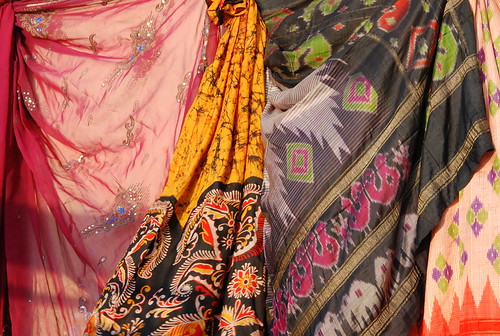
The city of Udaipur lies about 200 miles east of the Pakistan border and is in the heart of the region known as Rajasthan. Though I don't agree with those who call it the 'Venice of the East', the city is truly beautiful. The whitewashed buildings of the Old Town line the banks of Lake Pichola. The narrow, twisting roads leading away from the lake were filled with tiny craft and jewelry shops. The town might be most famous for the scenes from the classic Bond film 'Octopussy' that were filmed there.

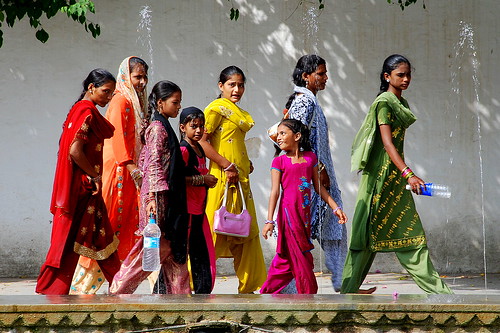
The lake sparkled at night, reflecting the soft white lights of the Old Town off its oil black surface. We sat atop our guest house eating a meal of tikka, dhal and naan under a star-filled sky and just took it all in.

As Harmony slept off her shopping hangover, I was out the door at dawn to explore town a little more. Up the street from the Hindu temple, motorbikes converged at the grade school in a cloud of exhaust fumes. Stray dogs still slept on the cool pavement, unfazed by the activity around them.
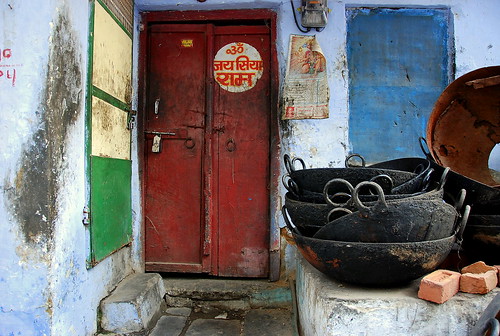
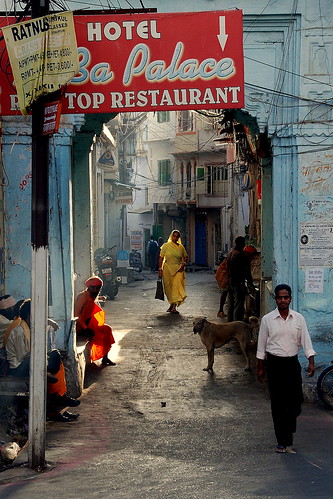
The lake is the center point of daily life in the city, providing water for bathing and cleaning. Before departing on our way east, we took a boat ride on the lake to see the city from a different perspective. Women in brilliantly-colored saris lined the lakeshore steps going about their morning routine.
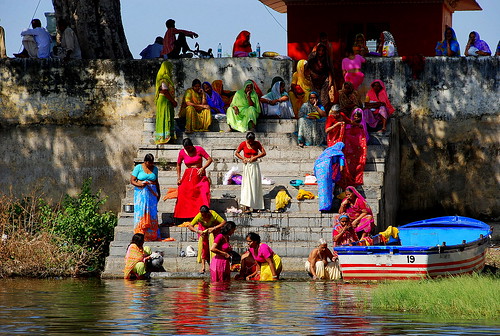
We hired a car and driver to take us to Jaipur, the capital of Rajasthan in the eastern end of the region. The drive would take over eight hours, so we decided to break it up with a stop in the countryside town of Shahpura. We stayed at Shahpura Bagh, a 120 year old garden estate that was formerly the summer home of the rulers of Shahpura. Today, the estate has been converted into a guest house surrounded by a nature preserve. The descendants of the regional royalty still live on the estate and we enjoyed talking with them about the way things were back in the day. A tiger that the family hunted in the surrounding area over 50 years ago was mounted to the wall of the living room.

We hurtled down the narrow, single-lane dirt road as the fading sun hung low in front us us. I held the door of the Mahindra jeep closed with my arm as the driver swerved to avoid cows in the road. The dry, flat Rajasthani countryside spread out on either side of us, with the only splashes of color coming from the dress of women walking down the side of the road carrying water on their heads. While Harmony cleaned off another day's dirt and sweat before dinner, I joined one of the men from the house on a ride out to a nearby village and old fort. He drove the jeep like he was being chased by the devil. When cows blocked the road completely, he would give them a long honk of the horn and a gentle nudge from the front bumper.
When we arrived in the village, a group of children ran up to me yelling "hello! hello!". Each wanted to shake my hand. The boys touched my feet as a sign of respect, as they would do to a village elder. I was honored!

We climbed the crumbling steps of what was once an impressive fort that towered over the neighboring farmland. Today, the fort is nothing but an empty shell that is now filled with vegetation. Regardless, we clamored to the top to take in the view of the area from the the lookout tower. We sat there and drank a cup of tea from his thermos as the sun was replaced in the sky by a full moon. The only sound came from the swallows and bats circling overhead. As darkness settled in, we felt our way down the steps and back to the car.
The next morning, I watched peacocks, wild pigs and owls in the nature preserve before taking a walk through the village. The town is small but was full of activity. Kids walked to school and farmers set up baskets of produce in the market. The local (camel) leather craftsman wanted me to take a photo of his sons. They laughed when I showed it to them.
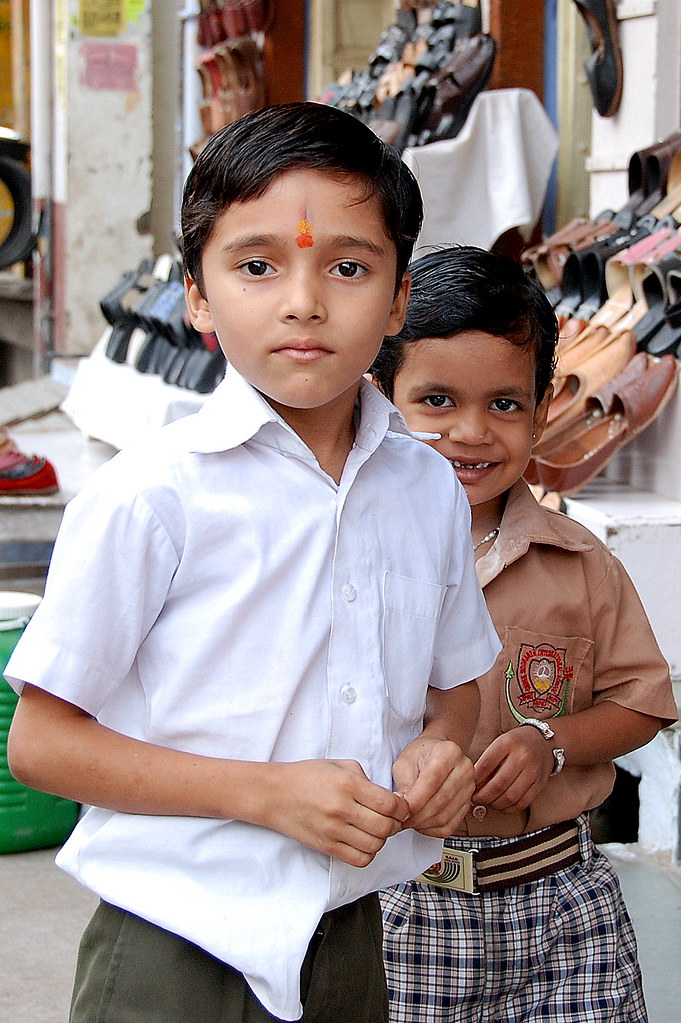
It was about a five hour drive to Jaipur, the so-called 'Pink City'. The streets were congested with traffic ... bikes fought for room with pedestrians, mopeds fought for room with bikes, cars with mopeds, etc ... in the middle of it all, camels pulled large wooden carts down the middle of the street. The five-story Hawa Mahal is probably the city's most distinctive landmark. It was built in 1799 to enable ladies of the royal household to watch the life and processions of the city go by while they remained concealed, per the protocol of the day.

Though Jaipur wasn't our favorite stop of the trip, it offered some really worthwhile stops. For instance, our ride up to the top of the Amber Fort was via elephant. The fort itself was pretty spectacular.
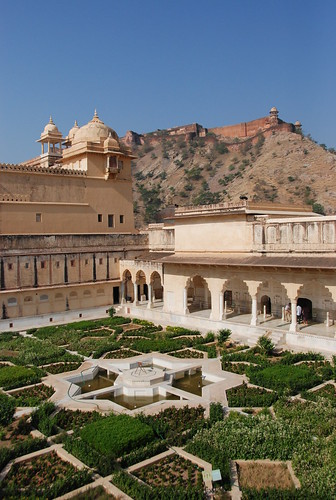
After a week in near 100-degree heat, though, the biggest attraction for us was the little pool along-side our guest house. Heaven! Our second night in Jaipur wrapped up with henna, traditional Indian music, great food and a palm reader.
Our last and final stop of trip took us from Rajasthan to the eastern state of Uttar Pradesh and the banks of the Ganges River. Varanasi is known as the "city of Shiva" and is thought to be one of the holiest places in India. Mark Twain once wrote that Varanasi "is older than history, older than tradition, older even than legend, and looks twice as old as all of them put together". After arriving in town, we made our way to the river to watch the nightly Ganga Aarti ceremony ... holy men put the river to sleep with prayers, bells, drums and fire. Hundreds of pilgrims flock here by foot and boat to attend.
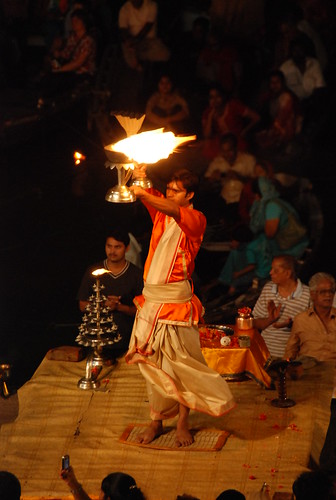
The next morning, we woke before dawn and made our way to river for a boat ride.
Varanasi is the heart of the Hindu universe and is a crossing place between the physical and spiritual worlds. For Hindus, to die here and have your ashes spread in the Ganges is to break the cycle of life and death. We both lit candles and set them on the river in memory of lost loved ones.
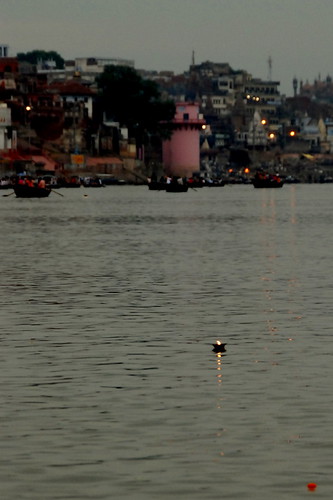
The boatman dipped his oars into the water and we glided quietly along the riverside ghats. Hindu pilgrims bathed in the river as sky began to brighten. Holy men struck yoga poses. Smoke rose from the burning ghats that perform public cremations on the river. Later in the morning we wandered the narrow streets of the old town, stopping in shops along the way.

On our second morning in Varanasi, the sun shine was brilliant at dawn as I crept along the ghats. Ankle-deep silt left by the high monsoon waters was only partially cleared, so I pressed into the throng of pilgrims as we snaked our way through the narrow open walkway.

I made my way to Kedar Ghat, took a seat on the steps, and just watched the morning activity around me. People bathed, prayed, washed clothes, sang and did yoga as they have been doing there for centuries. Some purchased water containers so they could bring a bit of the holy Ganges back to their homes.

Varanasi exemplified this sort of timelessness that seemed permeate each place we visited in India. True, its economy continues to grow at a heady pace; however, it is clear that the country is still deeply rooted in tradition.
India is a passionate country. The same spirit that led to the creation of the Taj Mahal and guided our taxi driver in Agra to put pen to paper 100,000 times can also be found everywhere in modern life in the country. Even cricket is less a sport and more a religion in India.
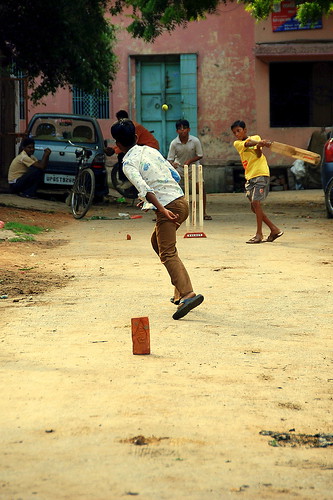
Before stepping foot in India, we were not sure what we would find when we arrived. After looking under the hood for the first time, we were pleasantly surprised with what we found. Sure, it can be confusing or challenging at times, but we both came away with the feeling that we want to see more of the country.
We will return again ... maybe to the south. We still need to kick the tires

